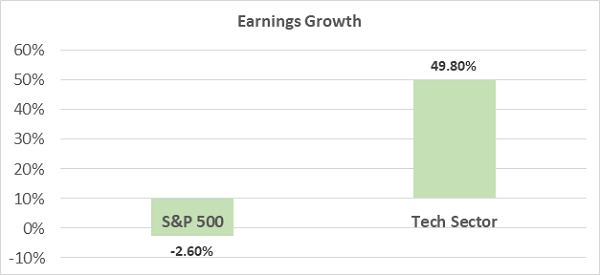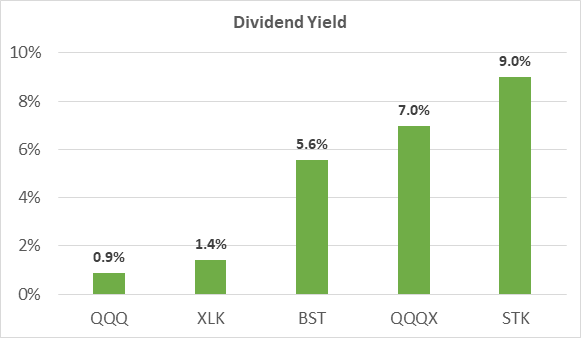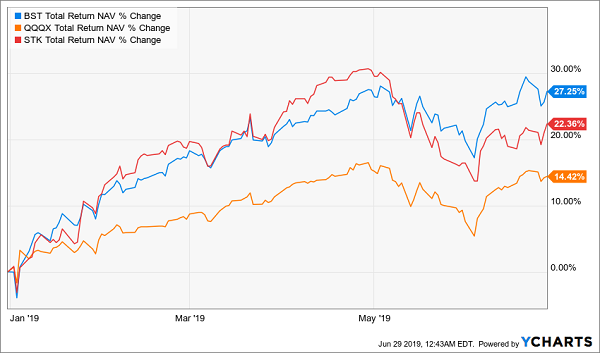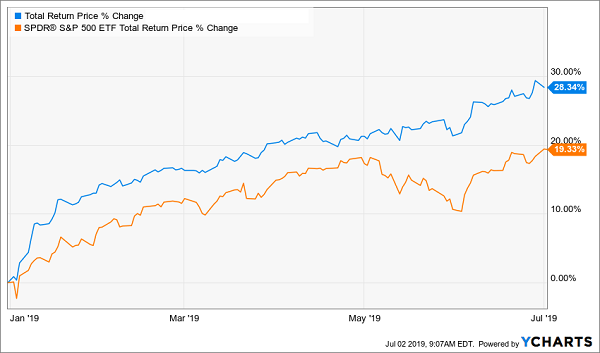Almost everyone walked right by the three monster dividends I’ll show you in a minute: they yield up to 9% now, and we’re looking at 15%+ price upside too!
The media always downplays these picks—and never gives them the credit they’re due, especially when it comes to their massive dividend payouts.
But a few folks are starting to see these three funds as the source of steady retirement cash (plus upside) they are. So you only have a short time—I’m talking days—to make your move here.
I’ll unmask these three steady retirement dividends shortly (including one that even pays you every month, as opposed to every quarter), and rank them from worst to first. First, I have to tell you that all three come from a place that will surprise you: the tech sector.
I know: technology is the last place most folks think to look for 9% dividends. Tech is, after all, best known more for big gains—think the 39,000% price gain you’d have banked if you’d bought Apple (AAPL) at its December 1980 IPO—than big dividends. (Apple pays a meager 1.5% payout today.)
So we’re not going to buy shares of Apple—and especially not its miserly 0%-paying cousins, like Facebook (FB), Alphabet (GOOGL) or Netflix (NFLX). Instead, we’re going to tap our big tech dividends through tech-focused closed-end funds (CEFs).
That’s because there are a few CEFs that invest heavily in tech firms while also paying dividends as high as 9%, like the three we’ll dive into shortly.
But before I do that, let’s talk about why you want tech now.
You might have heard that tech stocks are overvalued these days. There’s a good reason for this: the media loves to put out over-torqued, fear-driven stories about tech. On the investing side, much of this reporting points to one number: the sector’s supposedly “high” price-to-earnings ratio of 29.6, compared to 18.9 for the rest of the market.
But that “high” number is actually a bargain in disguise. Consider the numbers tech firms are putting up, with revenue growth of 12.7% annualized over 10 years, much more than the S&P 500’s 9.1% growth.
And these companies are doing an amazing job of converting those sales into skyrocketing earnings. Check out this chart:
A Hidden Value Play

Source: Fidelity, CEF Insider
While the broader market’s earnings are slumping, IT is seeing earnings up by nearly 50%!
Here’s the upshot: with that profit growth factored in, today’s 29.6 P/E ratio for tech would be just 17.1 in a year if prices don’t budge. Which means prices do look set to budge—higher.
That’s why tech is worth buying now: it’s the most overlooked value play out there!
3 Tech Dividends Up to 9%, Ranked Worst to First
Instead of trying to pick tech winners yourself, you could look to passive ETFs like the Invesco QQQ Trust (QQQ) or the Select Technology SPDR ETF (XLK). But neither is a great income play. As you can see below, there are three other options that are far better.

Source: CEF Insider
The three CEFs on the right of this chart focus on tech: the BlackRock Science and Technology Trust (BST), the Nuveen NASDAQ 100 Dynamic Overwrite Fund (QQQX) and the Columbia Seligman Premium Tech Growth Fund (STK). Let’s take a look at all three, starting with our third-best pick now.
That would be STK, which looks intoxicating with its 9% yield and portfolio of big names like Visa (V), Broadcom (AVGO) and Apple. However, STK sits in third spot due to its more limited upside potential: it’s now trading at a 2.4% premium to NAV, despite underperforming BST on a total-return-NAV basis for 2019.
Same Sector, Wildly Different Returns

In the No. 2 spot: QQQX, whose return is worse than that of STK this year. However, this fund is at least trading at a discount of nearly 1%, which doesn’t sound like a lot, but it has traded at an 8% premium recently. And while that premium will likely return soon, QQQX isn’t the best tech bet of our trio.
That would be BST. Not only is this CEF the top performer on a NAV basis for 2019, it’s also trading at a small (0.6%) discount to NAV. But BST has traded at a 10% premium to NAV as recently as February, and as high as a 15% in mid-2018.
When the market gets income-hungry and realizes the value in the tech sector, expect BST’s premium to return to that level, resulting in 15% capital gains on top of its 5.6% income stream (paid monthly). While that isn’t the highest yield of our three tech CEFs, BST’s capital-gains potential more than justifies taking the smaller income stream.
CRUCIAL: The 4 CEFs You Must Buy Now (8.7% Dividends, 20% GAINS Ahead)
As I just showed you, CEFs really do give you the best of all worlds: the huge dividends you need in retirement, plus price upside to grow your nest egg over the long haul.
And CEFs go well beyond tech. Right now I’m pounding the table on four other incredible funds that could give you a balanced portfolio all on their own.
This quartet gives you high, safe dividends (8.7% yields, on average, with the highest payer throwing off an amazing 10.7%). Those reliable payouts are backed by stable utilities, bonds and real estate investment trusts (REITs).
Plus, you get a hit of growth from the likes of finance and tech plays such Visa and Microsoft (MSFT), plus pharma picks famous for big breakthroughs, like Abbott Laboratories (ABT).
Here’s the real kicker: all four of my top CEF picks now trade at ridiculous discounts to NAV, setting us up for 20%+ upside in the next 12 months!
If you think that kind of growth is impossible from a dividend fund, think again: one of these four cash machines, which I’ll show you when you click right here, has already outrun the market this year, with a 23% return:
A 7.9% Dividend That Crushes the Market

Here’s the surprising part: despite that gain, this fund is still cheap! It trades at an 11% discount to NAV. Which is why I’m calling for another 20%+ gain in the next 12 months, to go with this fund’s rich 7.9% payout.
This is the beauty of investing in CEFs, and I can’t wait to share the name of this fund with you, plus my three other top CEF buys, too. Click here and I’ll give you full details on these four powerhouse income plays: names, tickers, buy-under prices and more.
